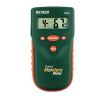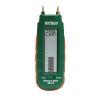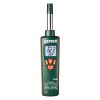Extech MO280-KW Water Damage Restoration Kit
The Extech Water Damage Restoration Kit is specifically designed for water damage restoration contractors.
Features
- Model MO210 pocket moisture meter measures building material moisture from 0.2 to 2%
- Model RH490 precision hygro-thermometer has 2% RH accuracy
- Model MO280 pinless moisture meter displays %moisture from 0 to 99%
- Free ground shipping
- Expedited repair and warranty service
- Lifetime technical support
- More
The Extech Water Damage Restoration Kit is specifically designed for water damage restoration contractors who monitor job site conditions, progress, and insurance company reporting. The kit is supplied in an attractive storage case that provides protectionand organization for the testers whenever they are needed. It includes:
Model MO280 pinless moisture meter for measurement depths to 0.75 inches below the surface with 10 different wood types to select from. Model MO210 pocket moisture meter measures wood moisture from 6 to 44% and building material moisture from 0.2 to 2%. Model RH490 precision hygro-thermometer has a less than 30 second RH response time with 2% RH accuracy and wide measurement ranges.
- (1) MO280 Pinless moisture meter
- (1) MO210 Pocket Moisture Meter
- (1) RH490 Precision Hygro-Thermometer
- (1) Storage case
In The News
Three Decades of Research at Acton Lake
A multi-disciplinary team at Miami University, Ohio, has been studying the environmental change at Acton Lake for over three decades. Using three different NexSens buoys over this time, the team has an incredible archive of data that is helping build a picture of Acton’s past, present, and future. Until recently, a NexSens CB-50 buoy was used alongside other environmental monitoring at Acton Lake. In May 2025, the Miami team deployed a new XB-200 buoy , future-proofing their ongoing monitoring using real-time buoy systems. Acton Lake, a small hypereutrophic reservoir in southwest Ohio, covers 2.4km² and has a maximum depth of about 8m. The dam was built in 1956, and the lake has a large agricultural watershed.
Read MoreSource Water Monitoring in Albany, New York: Tracing Water Quality throughout Tributaries
Thousands of US cities pull their drinking water from natural source waters like reservoirs, rivers, and streams, making overall watershed health a key consideration for water providers. In Albany, New York, the Albany Department of Water and Water Supply delivers drinking water to over 100,000 residents as well as monitors and manages the larger drinking water supply watershed. Hannah Doherty, Environmental Specialist at the Albany Department of Water and Water Supply , spends her days working with a small team to monitor the drinking supply and the connected water bodies. Doherty explains, “We’re the first to encounter the water that ends up being the drinking water.
Read MoreWildfire Prevention in the Sierra Nevada Region with the Yuba Watershed Institute
Though recent wildfires have sparked new conversations about wildfire management and response, groups like the Yuba Watershed Institute have been monitoring the forests and water resources of the Sierra Nevada region for decades, managing approximately 5,000 acres of land with the Bureau of Land Management (BLM) and about 7,000 acres in private land partnerships. The goal of the Institute is to work with local communities and land agencies to improve watershed and forestry management through informed practices and public outreach. The goals of the Yuba Watershed Institute are three-fold: Improve the ability of fire suppression agencies like the California Department of Forestry and Fire Protection ( CAL FIRE ) and the US Forest Service.
Read More









